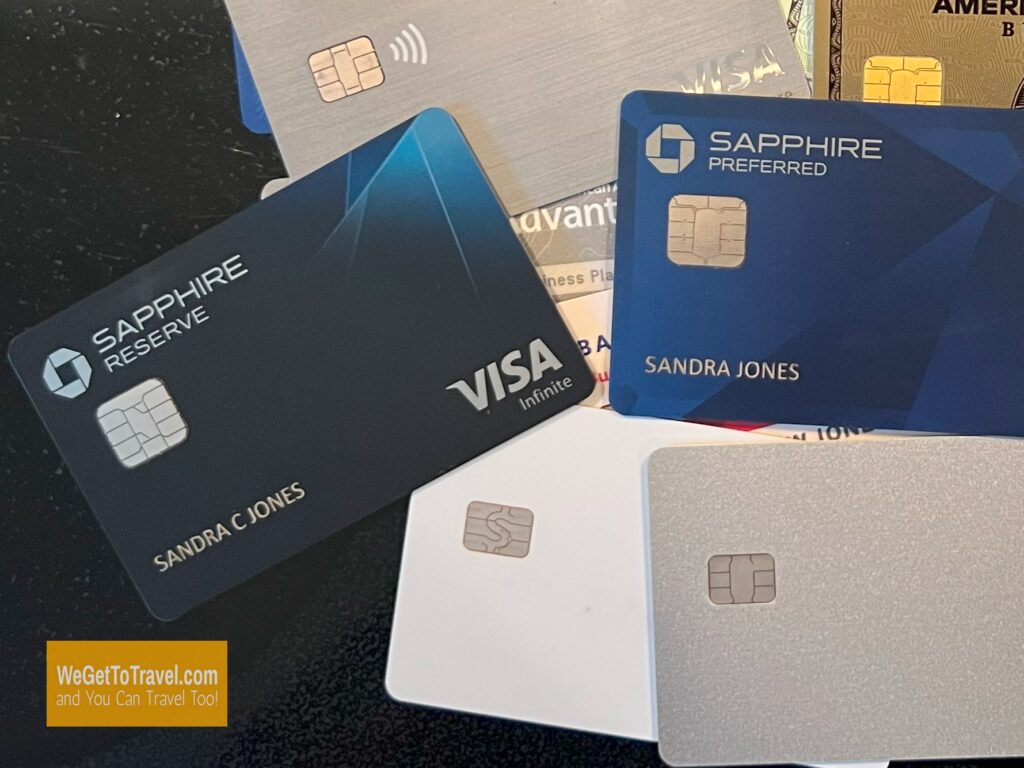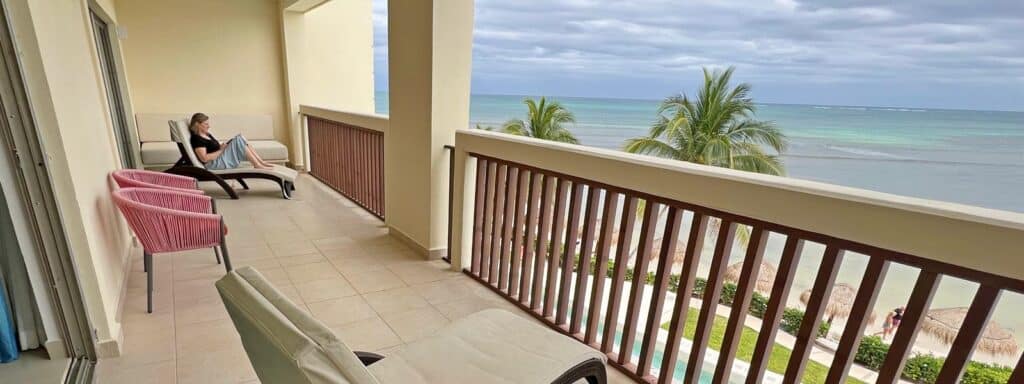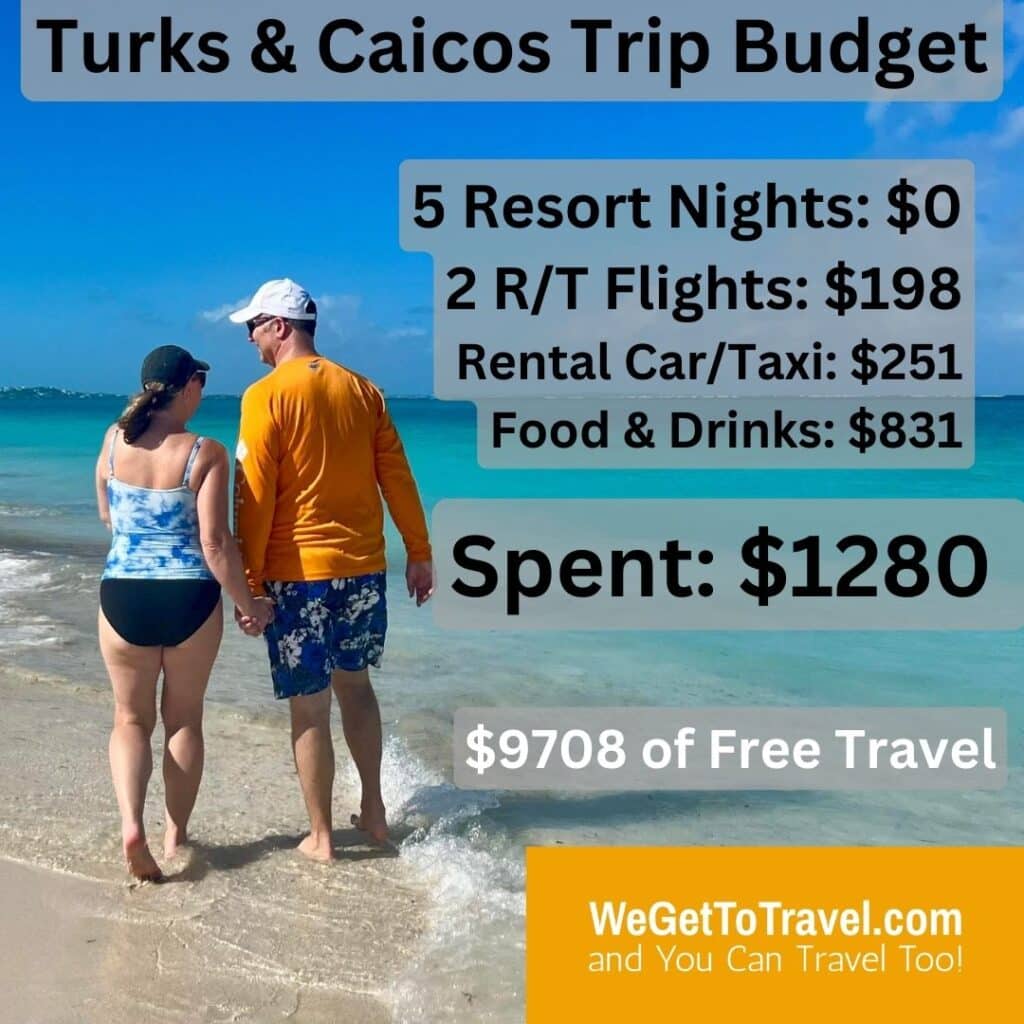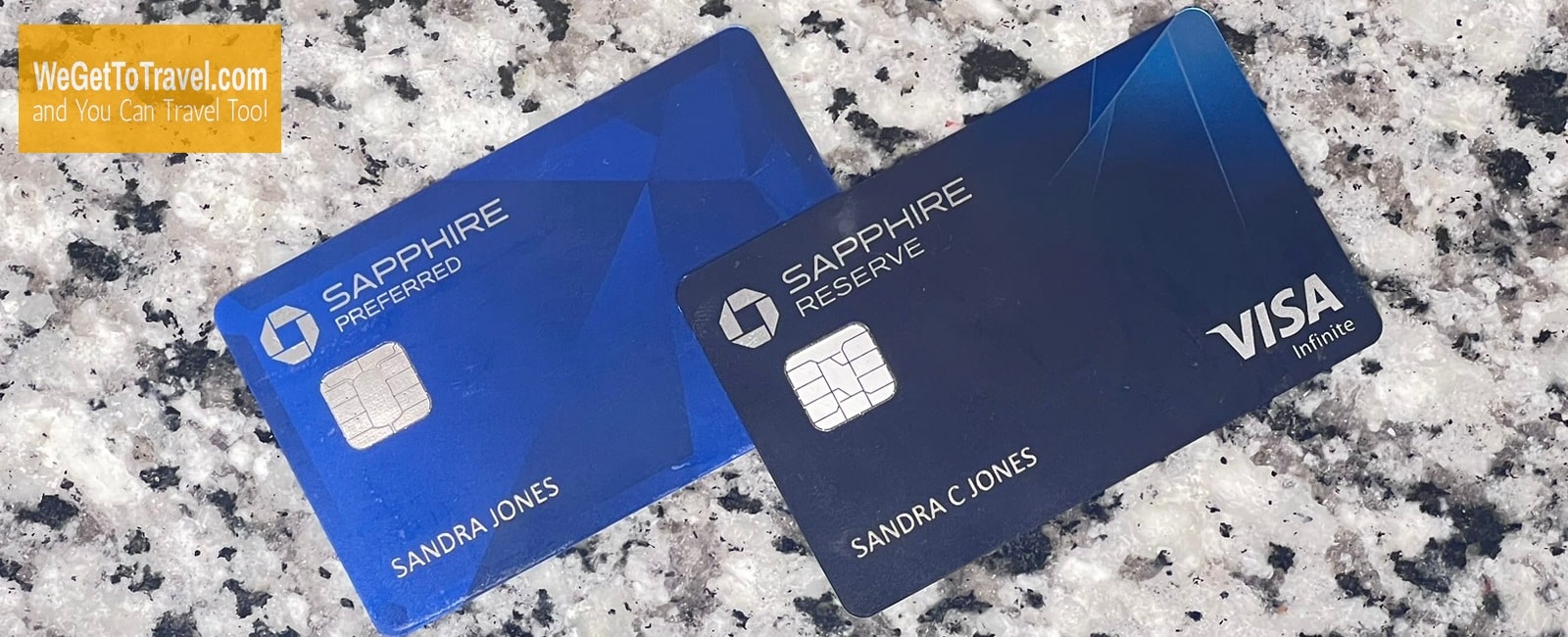After earning 4,000,000+ points and redeeming for more than $130,000 in free travel, we’ve learned a thing or two about optimizing credit card rewards.
When we started with travel rewards in 2021, one of our first decisions was which Chase Sapphire card to get. I went with the premium Chase Sapphire Reserve®, while Sandra (aka Zuzu) opted for the more budget-friendly Chase Sapphire Preferred® Card.
Over the years, we’ve put both cards through their paces, and we’ve got real insights to share.

So which Chase Sapphire card is right for YOU?
That’s what this guide is all about—helping you decide which of these fantastic cards deserves a spot in your wallet.
Sapphire Preferred vs Reserve: TL;DR
Take 10 or more trips per year AND love optimizing credit card benefits? The Sapphire Reserve is worth it.
Take fewer trips or want something simple? Get the Sapphire Preferred.
Why the change from my previous, simple “5-trip rule”? In 2025, Chase made the Reserve much more complex and expensive. The benefits are better, but they require time and effort to maximize.
I think frequent travelers can get a ton of value from the Reserve: $300 travel credit, lounge access, best in class travel insurance, plus new credits for dining, hotels, entertainment, and streaming. But you really need to use most of these benefits to justify the higher fee.

My new rule of thumb: if you take ten trips or more per year AND you’re willing to spend time optimizing all the credits and benefits, the Sapphire Reserve could work for you. But honestly, most people will get better value from the simpler Preferred card.
Chase Sapphire Preferred:
- Great award travel starter card
- $95 annual fee
- 75k point welcome bonus after spending $5,000 in 3 months
- Points worth 1-1.75 cents each through Chase Travel
- Solid travel protections
- Good for occasional travelers (fewer than ~10 trips per year)
- Simple and straightforward benefits
- Great if your regular travel partner has the Sapphire Reserve
- Click here to apply
Chase Sapphire Reserve:
- $795 annual fee
- $300 annual travel credit (effectively reducing fee to $495)
- 125k point welcome bonus after spending $6,000 in 3 months
- Points worth up to 2 cents each through Chase Travel
- Airport lounge access and premium travel protections
- $300 annual dining credit, kinda
- $300 StubHub credit
- $300 hotel credit, kinda
- $250 Apple TV credit
- Better for very frequent travelers (10+ trips per year) who will optimize benefits
- Complex benefits requiring time investment
- Click here to apply
That’s the short version of how to pick between the Chase Sapphire cards! Keep reading for our detailed comparison and our real travel experiences with these cards.
We’ve Got Both Sapphire Cards
When I decided to dive into credit card rewards a few years ago, I went straight for the Chase Sapphire Reserve even though it has (what seems like) a crazy high annual fee.

I did waaaaay too much research (that’s just how I am) and I realized that the airport lounge access and enhanced travel benefits would be worth the higher annual fee.
Zuzu, who rarely travels without me, chose the Chase Sapphire Preferred as her first rewards card. It had a lower annual fee and some different benefits vs the Sapphire Reserve.
If you’re not an advanced points and miles person, the Sapphire Preferred is a fantastic gateway into the world of (almost) free travel.
After holding both cards for several years now, we’re in a unique position to compare them directly based on our real experiences.
Annual Fee Comparison
Let’s start with the most obvious difference. That $700 Annual Fee difference looks massive at first glance.
Chase Sapphire Preferred: $95 annual fee
Chase Sapphire Reserve: $795 annual fee
But here’s where the math get interesting…
Chase Sapphire Reserve Automatic $300 Credit
The Chase Sapphire Reserve includes a $300 annual travel credit that’s automatically applied to the first $300 in travel purchases each year. Since we’re all travelers here, you’ll almost certainly use this credit without even thinking about it.
Our annual travel budget is usually around $4-8k. That’s our budget for ALL of our out-of-pocket costs and it’s easy to get full use of that $300 travel credit.

That brings the effective annual fee of the Sapphire Reserve down to $495.
Chase Sapphire Preferred $50 Portal Credit
While the Preferred offers a $50 annual credit, it’s not as easy as the Reserve’s $300 credit. You have to book a hotel stay through the Chase Travel Portal to get the $50 Preferred credit. It’s not automatically applied to all travel like the Reserve’s $300 credit.
And honestly, we’ve never used it. We’ve never booked a hotel via the Chase Travel Portal. (But we have booked a rental car with the Chase Portal.)
If you do use the Preferred’s $50 credit, your effective annual fee is only $45. But for us, we do our analysis based on the full $95 annual fee.
So the real comparison becomes: Is the Reserve worth an extra $400 per year compared to the Preferred?
For a few frequent travelers (like me), that answer is yes. For others (like Zuzu), that answer is no.
Welcome Bonus Comparison
Here’s where the Chase Sapphire Reserve currently has a big advantage:
Chase Sapphire Preferred: 75k points after spending $5k in 3 months
Chase Sapphire Reserve: 125k points after spending $6k in 3 months
The extra 50,000 points from the Reserve’s Welcome bonus is huge!
Wonder how you can spend $5-6k on a new credit card in just 3 months? Download our free eBook with 14 pages of our best secrets!
When redeemed through the Chase Travel portal, the Preferred’s 75,000 points are worth about $1000 in travel. The Reserve’s 125,000 points are worth up to $2,500 through Chase Travel with Points Boost.
So right off the bat, the Reserve gives you around $1,500 more in travel value just from the welcome bonus – if you can maximize the Points Boost feature.
Real World Points Value
We transfer nearly all of our Chase points to Hyatt. Based on over 50 redemptions, we have historically gotten a 3.6 cents value per point since we started tracking our use of Hyatt points in 2021.

We’ve visited 14 All Inclusive resorts in Jamaica, Mexico & the Caribbean in just 4 short years. Almost all have given us outsized value from our Chase points and it’s incredible to check-out of a fancy resort with a $0 balance!
But you don’t have to take 2-3 beach trips every year like we do to get incredible value from Chase points.
We also love to use our Chase points (transferred to Hyatt) for trips to big football games!
Zuzu & I are huge Tennessee Vol football fans. We love going to games, but hotel cash prices get jacked up when there’s an extra 101,915 folks in town to cheer for the Vols.
For instance, last time we played that team from Alabama, cash rates for the Hyatt Place in downtown Knoxville skyrocketed up to $1,699 per night!
We’d never pay that much cash for a hotel, but we used 12,000 Chase/Hyatt points per night for a room there. Each Chase point was worth… holy cow: over 15 cents!

And we got to pregame and celebrate our win with thousands of other VOL fans in the heart of Knoxville.
When you’re getting that kind of value from your points, the difference between the annual fees on these 2 cards is pretty insignificant.
Earning Rates Comparison
Both the Sapphire Preferred and the Sapphire Reserve cards earn valuable Chase Ultimate Rewards points, but with different bonus categories:
Chase Sapphire Preferred:
– 5x points on travel purchased through Chase Travel
– 3x points on dining, select streaming services, and online grocery purchases
– 2x points on all other travel
– 1x points on everything else
– 10% anniversary points bonus on your total annual spend
Chase Sapphire Reserve:
– 8x points on all travel booked through Chase Travel
– 4x points on flights & hotels booked direct
– 3x points on dining
– 1x points on everything else
Both cards also currently offer 5x bonus points on Lyft rides.

For most everyday spending, the Sapphire Preferred actually offers as good or better earning rates compared to the Sapphire Reserve, especially with the 3x on streaming services and online groceries and the annual 10% points bonus.
Sapphire Preferred is Better for Groceries
Since Zuzu & I almost always travel together, we seldom use her Chase Sapphire Preferred for travel-related expenses. But most people don’t know that the Chase Sapphire Preferred has a bonus category for online grocery shopping, which pays 3 points per $1 spent.
The trick that’s not common knowledge is that most grocery store mobile apps allow you to put your Chase Sapphire Preferred in their wallet as a payment option. So when we use Kroger Pay in-store at checkout, we always get 3x per dollar because it qualifies as online grocery payment, even though we’re physically inside the store at the cashier.
That’s a pretty sweet hack for everyday spending!
Redemption Value Comparison
If you book travel though the Chase Travel Portal, there’s a key difference between these cards:
Chase Sapphire Preferred: Each point worth minimum 1 cent or up to 1.75 cents
Chase Sapphire Reserve: Each point worth minimum 1 cent or up to 2 cents
This means 10,000 points would be worth:
– $100-175 in travel with the Preferred
– $100-200 in travel with the Reserve
That difference adds up quickly when you’re redeeming large amounts of points.
But here’s the thing… we rarely use the Chase Travel Portal for hotels and flights.
Both cards allow you to transfer points at a 1:1 ratio to the same 14 airline and hotel partners, including favorites like Hyatt, Southwest Airlines, and United.
In our experience, transferring to partners (especially Hyatt) almost always provides the highest value for your points.
When we transferred Chase points to Hyatt for our stay at the Park Hyatt New York, we got a value of 4.3 cents per point! That’s why we almost always transfer our points rather than using the Chase Travel portal.

While there are a few times that we used points in the Chase Travel Portal, I’m pretty sure that getting 4.3 cents per point is better than just 1 or 2 cents per point, lol.
Points Boost & The Edit Hotels: Complex but Potentially Valuable
Points Boost is Chase’s new feature offering dynamic deals on select hotels and flights for a limited time through Chase Travel. Your points are worth more on these deals, but they’re constantly changing.
With the Sapphire Reserve, you get up to 2x point value (2 cents each) on select hotels and flights through Points Boost. The Preferred gets up to 1.5x on select hotels and up to 1.75x on select flights.
It used to be more simple: Sapphire Reserve points were worth 1.5 cents & Sapphire Preferred points were worth 1.25 cents each. That changed in 2025.
For most people, I think the loss of simplicity is a negative. You have to constantly check what deals are available and hope what you want is included. But for people who are looking to chase a deal and are willing to invest time in optimizing (like Zuzu & me), it could be a positive.
The Sapphire Reserve card gets a $250 credit every 6 months to Chase’s new collection of hotel, The Edit. That credit, combined with Points Boost opens up more travel options for us. We’ve been very loyal to Hyatt because we get excellent elite benefits as Hyatt Globalists. Plus, we almost always get outsized value by transferring Chase points to Hyatt points.

Now, The Edit Hotels will be offering us extra benefits similar to elite-level guests, plus we get a semi-annual $250 credit and our points are worth a respectable 2 cents each at these hotels.
Here’s an example of how we might use these new credits for The Edit:
In our hometown of Nashville, one of the oldest fancy hotels is the Hermitage Hotel. It’s never been a place we considered for a staycation because it wouldn’t be practical to book with points.
But now by combining the $500 Edit hotel credit we get every year plus using Chase points at 2 cents each, it’s possible we could actually stay at this historic and luxurious hotel.
Premium Travel Benefits
Beyond the annual fee and points, the biggest differences between these cards are in their travel benefits:
Chase Sapphire Preferred:
- $50 annual hotel credit through Chase Travel
- No foreign transaction fees
- DoorDash benefits: DashPass subscription and monthly credits
- Access to The Edit by Chase Travel (special hotel benefits)
- Click here to apply
Chase Sapphire Reserve:
- $300 annual travel credit
- Priority Pass Select membership (airport lounge access)
- Access to Chase Sapphire Lounges
- Up to $120 statement credit for Global Entry/TSA PreCheck every 4 years
- No foreign transaction fees
- Enhanced DoorDash benefits with additional monthly credits
- 4 free roadside assistance service calls annually
- Enhanced benefits with The Edit by Chase Travel
- $500 The Edit Hotel collection credit ($250 each 6 months)
- $300 annual dining credit at Sapphire Reserve Exclusive Tables restaurants
- $300 StubHub credit
- $250 Apple TV credit
- Click here to apply
Airport Lounge Access with Sapphire Reserve
Airport lounge access is one of the biggest perks that sets the Reserve apart.
On our one week trip to Germany and Switzerland, we had a pretty long layover at LaGuardia airport in NYC. There’s a fantastic new Chase Sapphire lounge at LGA where we ate, drank, and relaxed in comfort during our five-hour wait for our flight home to Nashville.
In addition to Chase Sapphire lounges, the Reserve also gets you into Priority Pass airport lounges.
You don’t get access to any airport lounges with the Sapphire Preferred. But Zuzu gets in lounges for free when she travels with me. The Reserve allows 1 or 2 guests to come in for free with the cardholder.
International Travel: Better with Sapphire Reserve
I really like that I don’t have to worry about foreign transaction fees when I use the Chase Sapphire Reserve card on our international trips. And there are usually airport lounges that we can get into in foreign countries.

At the Punta Cana airport, there are actually two SWIMMING POOL lounges that you can get into with the Sapphire Reserve which overlook the runway! Those are some of the most Instagram-worthy airport pictures that you will ever see.
One Disappointment with the Reserve
Every year, I do the math to decide if we’ll keep the Reserve. Every year, the math says it’s worth keeping. But it’s not perfect, and the math got a little worse last year.
I don’t think it’s coming back, but there used to be a Priority Pass restaurant benefit with the Chase Sapphire Reserve. At our home airport of Nashville, there was a pretty good restaurant in terminal C where we could get $56 of free food and drink anytime we were in the airport, thanks to my Sapphire Reserve.
The food was really good, and it was super convenient to get a good meal before our flights. Unfortunately, they canceled that benefit last year. It would be great if they brought it back because that was easily worth $500 every year to us.
Chase, are you listening??
But even with the loss of that perk, the math is easy: we get MUCH more value out of the Chase Sapphire Reserve than we pay for the annual fee.
The New Credits: Great for Optimizers, Complex for Everyone Else
The new Reserve comes with a bunch of additional credits that look great on paper: $300 dining credit, $300 StubHub credit, $500 Edit hotel collection credit, and $250 Apple TV credit. That’s $1,350 in potential value!
But here’s the thing – these credits aren’t as straightforward as they seem (hence my “kinda” notes above).
I think Zuzu & I will get maximum value from most of these credits.
The $500 Edit hotel collection credit should be easy to use since we already stay at nice hotels. There’s a good chance we’ll use most of the $300 annual dining credit at restaurants that are part of the Sapphire Reserve Exclusive Tables program (more date nights in Nashville for us!). I’m pretty sure we’ll use the $300 annual StubHub ticket credits between sports and other events we were going to go to anyway. The Apple TV credit should save us $250 per year.
So for us, the additional value will definitely be more than the additional annual fee. But most people won’t optimize like we do.
If you want a simple card with straightforward benefits, the new Reserve isn’t for you. Get the Sapphire Preferred instead.
If you enjoy maximizing every credit and don’t mind spending time figuring out how to use them all, then these new Sapphire Reserve benefits could be valuable.
Travel & Purchase Protections
Both cards offer valuable travel protections, but the Reserve edges out the Preferred in several categories:
Trip Delay Reimbursement:
– Preferred: Coverage begins after a 12-hour delay
– Reserve: Coverage begins after only a 6-hour delay

Auto Rental Insurance:
– Both offer primary coverage
– Preferred: Doesn’t cover expensive or exotic cars
– Reserve: Covers some expensive and exotic cars with higher coverage limits
Purchase Protection:
– Preferred: Up to $500 per claim
– Reserve: Up to $10,000 per claim
The Chase Sapphire Reserve® also offers these additional travel protections not available on the Sapphire Preferred:
– Emergency medical and dental coverage (up to $2,500)
– Emergency evacuation coverage (up to $100,000)
Fortunately, we’ve never had to use the CSR’s trip delay or purchase protection. But it sure is nice to know it’s there if we get a significant delay.
COST to ENJOYMENT Ratio
When we finally got to travel, we came up with our own Cost to Enjoyment Ratio. It’s how we measure how much enjoyment we squeeze out of every dollar we spend.
While our Cost to Enjoyment Ratio doesn’t apply as directly to credit cards as it does to trips and resorts, you’re required to have one of these 2 Sapphire Cards (or the Business Ink Preferred card) to use Chase Ultimate Rewards points.
You can kind of look at the annual fee as the Cost of Entry into the points and miles game. The Preferred is $95 per year and the Reserve is now $495 once you factor in the automatic $300 annual travel credit.
That’s a big jump from the pre-2025 effective fee of $250 for the Sapphire Reserve. But if you can use most of those new credits, the math still works.

Since we average over $30,000 of free travel each year from points and miles, those annual fees are pretty easy to swallow. We’re getting much more Enjoyment from the annual fee COST than from most anything we’ve ever done.
But here’s the key difference now: the Reserve requires time and effort to maximize all those credits. The Preferred is simple – pay $95, get solid benefits, done. The Reserve is complex – pay $495 (after travel credit), then spend time optimizing dining credits, hotel credits, entertainment credits, etc.
For us optimizers, that’s fine. For most people who want simplicity, that’s a problem.
Who Should Get the Chase Sapphire Preferred?
The Preferred is likely the better choice if:
- You take fewer than 10 trips per year
- You’re new to travel rewards and want a lower annual fee
- You already have lounge access through another card or airline status
- You value the 3x points on streaming and online groceries
- You don’t care about airport lounge access
- You want simple, straightforward benefits without complexity
- You don’t want to spend time optimizing multiple credits and benefits
- Click here to apply
Who Should Get the Chase Sapphire Reserve?
The Reserve makes more sense if:
- You take 10 or more trips per year
- You value airport lounge access
- You’ll use the Global Entry/TSA PreCheck credit
- You redeem lots of points through the Chase portal (for the up to 2x value)
- You want the strongest travel protections available
- You’ve had trip delays in the 6-12 hour range before
- You spend heavily on travel and dining
- You have an optimization mindset and enjoy maximizing credits
- You’re willing to invest time in using dining, hotel, entertainment, and streaming credits
- You don’t mind complexity in exchange for potentially higher value
- Click here to apply
What About Existing Cardholders?
So what about those of us who already have the Chase Sapphire Reserve? Are we keeping it or canceling?
For me, the answer is easy: I’m keeping it.
I had already justified the $550 annual fee before this 2025 price increase. While I would prefer a simpler credit card benefits program, I know I’ll easily be able to get more value than this price increase.
But I think most people will not be able to do that.
The key difference is that I enjoy optimizing and getting maximum value from credits. I’ll spend the time to figure out how to use the dining credit at Sapphire Reserve exclusive restaurants. I’ll book Edit hotels when we travel to use that $500 credit. I’ll buy tickets through StubHub when we go to games and events. And we already pay for Apple TV anyway.
Most existing cardholders won’t want to put in that much effort. If you’re someone who got the Reserve for the simple $300 travel credit and lounge access, these new complex benefits might not be worth the extra annual fee. It jumped by $245 per year from $550 to $795!
The honest truth? If you valued simplicity and got the Reserve because it was straightforward, you might want to consider downgrading to the Preferred. The new Reserve is designed for optimizers, not for people who want simple benefits.
But if you’re like me and enjoy maximizing every benefit, the new Reserve offers more value than ever – you just have to work for it.
Frequently Asked Questions
Which Chase Sapphire card is better for beginners?
The Chase Sapphire Preferred is better for beginners because of its lower $95 annual fee and solid travel benefits without overwhelming premium features.
How many trips per year do I need to take to justify the Reserve?
If you take 10 or more trips per year, the Chase Sapphire Reserve’s premium benefits (lounge access, $300 travel credit, better protections) can justify the higher annual fee.
Can I have both Chase Sapphire cards?
Yes, Chase allows you to hold both Sapphire cards at the same time.
The Bottom Line: Would We Choose These Cards Again?
Absolutely YES.
The Chase Sapphire cards have been the foundation of our entire points and miles strategy, allowing us to travel more than we ever thought possible.
For most people just starting out with travel rewards, we recommend the Chase Sapphire Preferred. Its lower annual fee makes it an easy choice for you if you take fewer than 10 trips per year, and the benefits are straightforward without requiring optimization.
The Reserve is now a specialized card for frequent travelers who enjoy complexity and optimization. If you travel at least 10 times per year AND you’re willing to spend time maximizing dining credits, hotel credits, entertainment credits, and all the other benefits, the Chase Sapphire Reserve can provide incredible value.
But if you want simple, reliable benefits without the hassle, stick with the Preferred. There’s no shame in choosing simplicity over complexity.
And remember, you can’t earn a welcome bonus on a new Sapphire card if you’ve received that card’s welcome bonus in the past 48 months.
Ready to Get Started with Travel Rewards?
If you’ve been thinking about getting into points and miles to enjoy luxury travel like we do, both Chase Sapphire cards offer solid welcome bonuses to get you started!
For very frequent travelers who love optimization, the Chase Sapphire Reserve’s 125k point welcome bonus is historically high and likely won’t stick around long.
Use our links below to apply and we’ll both win!
- Chase Sapphire Preferred – Our top recommendation for most people taking fewer than 10 trips per year
- Chase Sapphire Reserve – For frequent travelers (10+ trips) who’ll optimize the complex benefits
Why We’re Sharing This With You
So what’s the catch? Why are we giving you all this info for free?
If you get a new credit card after clicking through one of the links here or on our website, we’ll earn a referral bonus from the bank.

Most of the credit card companies like Chase have a refer-a-friend program. In this case, if you get one of these Chase Sapphire credit cards after you click through our link to apply, Chase will give us 10k points.
If you go to the Chase website directly & don’t go through our link, you’ll still get the same card with the same bonus, but Chase won’t give anyone that referral bonus.
So our help is free to you because (hopefully) you’ll apply through our links and the banks will pay us a referral fee. Thanks for helping us get more free travel!
Important Disclaimer
I know the Internet makes everything look great 100% of the time but credit cards are NOT always for everyone.
There was a time in our lives where we probably would have gotten into trouble with credit cards. Here are 4 times when you should NOT get a credit card:
1) If you’ve got a significant amount of consumer debt, pay that off before you get a new credit card.
2) If you can’t (or won’t) pay off your entire credit card balance (not just the minimum) every month, do not get a credit card.
3) If having a credit card will make you spend more than you would have with cash or a debit card, do not get a credit card.
4) If you’re planning to buy a house &/or get a new mortgage in the next few months, don’t get a credit card.
But if you’re at a point in your lives where you can ALWAYS pay off your credit card in-full, on-time every month, you can unlock INCREDIBLE VALUE by learning from what we’ve done in the past few years.
Ready to Travel More for Less?
Have you decided which Sapphire card is right for you? Or do you have questions about how to choose? Email us at wegettotravel@gmail.com and we’ll help you make the best decision for your situation!
– Ross & Zuzu

Hello there…
As a CSR cardholder I am just wondering if you are keeping it at the new AF rate? I have it from day one and I would keep it even at $795 a year, but the new reward structure is just less appealing to me. I travel once a year to Europe, usually business or premium class, not big fan of lounges though and that’s the most of it. The rest is local, car rentals, subscriptions,tolls, dining etc.
So, my plan- cancel CSR and get United Quest, churn, burn, that’s that.
All the best.
Hi Peter, I updated the blog post to address your question. For me, it’s an easy YES to keep the Sapphire Reserve card. I already justified keeping it with the old $550 Annual Fee, so it’s just $245 extra now. Since I’m an optimizer, I know I’ll get max value out of several of the new credits.
wrt the new CSR credits, I think we’ll use the $300 dining credit, $300 StubHub credit, $500 Edit hotel collection credit, and $250 Apple TV credit. On paper, that’s $1350 MORE than the old card so I’m good with the AF increase.
But sounds like it’s not going to be as easy for you to justify vs the United Quest card. It depends on where your expenses are. If you spend much on dining, non-United flights and hotels, you might come out ahead with the CSR. And I value transferrable points highly. You’d be giving that up if you move your spend to the Quest from the CSR since the Quest only earns United miles.
My default recommendation is to have 1 Sapphire card + the Freedom Unlimted. Might be a better deal for you to drop the CSR, get a new Sapphire Preferred for its bonus categories (the AF is only $95) and then get the Freedom Unlimited. That way, you’re getting at least 1.5 transferrable Chase points on every dollar you spend. Unless you spend a ton on United, I bet you’ll come out ahead that way. Let me know what you think!